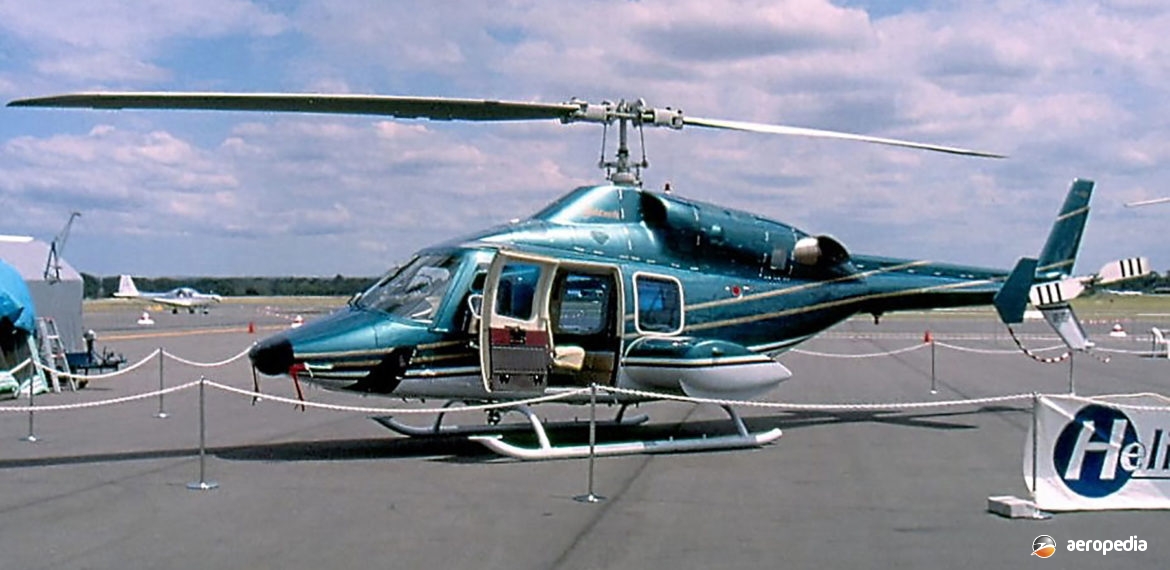Photograph:
Bell 222U VH-TSP (c/n 47532) of Reef Helicopters at Bankstown, NSW in November 2000 (David Eyre)
Country of origin:
United States of America
Description:
Light utility helicopter
Power Plant:
Two 510 kw (684 shp) Avco Lycoming LTS 101-750C-1 turboshafts
Specifications:
- Rotor diameter: 12.8 m (42 ft)
- Fuselage length: 12.85 m (42 ft 2 in)
- Height: 3.51 m (11 ft 6 in)
- Main rotor disc area: 128.7 m² (1,395.4 sq ft)
- Max speed at sea level: 278 km/h (172 mph)
- Max speed at 1,220 m (4,000 ft): 289 km/h (179 mph)
- Economical cruising speed at sea level: 246 km/h (153 mph)
- Max rate of climb: 512 m/min (1,680 ft/min)
- Service ceiling: 4,815 m (15,800 ft)
- Range with max fuel at 1,220 m (4,000 ft) and 20 mins reserve: 691 km (429 miles)
- Empty weight: 2,210 kg (4,874 lb)
- Loaded weight: 3,742 kg (8,250 lb)
History:
In 1974 the Bell Helicopter Company announced its intention to develop the Model 222, and the first of five prototypes was flown for the first time on 13 August 1976. This model received FAA certification in pre-production configuration on 16 August 1979.
In 1978 an initial production series of 250 examples was commenced, the first production aircraft being delivered on 16 January 1980, some 55 examples having been delivered by the beginning of 1981.
Several versions were developed, including an executive version with a flight crew of two and five or six passengers; the Model 222 Offshore with accommodation for eight passengers and a flight crew of two with dual pilot IFR capability for over-water flying, an emergency flotation system, auxiliary fuel tanks and Collins Microline Avionics; and the standard Model 222 for utility use.
The first Model 222 to arrive in Australia was imported by Bell Textron Australia in 1981. It only required slight modification to meet Australian airworthiness standards, this including the addition of taxiing lights. Power was provided by two Lycoming LTS101-650C-2 or LTS101C-3 engines, depending on requirements for high altitude operation, each providing 503 kw (675 shp) for 2½ minutes, and 461 kw (618 shp) continuous. Standard fuel was 710 litres (156.18 Imp gals) in five rupture-resistant cells mounted near the centre of gravity. A special purpose (ie, as long range ferry, surveillance, etc) tank could be installed in place of the rear seat, holding 208 litres (45.75 Imp gals) in the parcel shelf area. After a sales tour this aircraft was not sold locally and was returned to the USA.
In 1982 the Model 222B appeared, this differing from the original model in having a larger main rotor and an up-rated power plant. Later a utility version appeared in 1983, known as the Model 222UT. The most obvious external difference on this model was the adoption of a skid-type undercarriage in lieu of the retractable tricycle-wheel type unit. Other modifications included a change in the electrical system to Direct Current, and the installation of Lycoming LTS101-750C-1 engines of 507 kw (680 shp), which provided some performance benefits. There was also some re-design of the tail rotors, enhancing the hot and high capability. The removal of the wheel undercarriage and associated hydraulic lines, etc, permitting an increase in fuel capacity.
A total of 182 examples had been delivered when production ceased in 1988, the market suffering a downturn in this period.
In 1990 Heli-Air in Lousiana commenced re-engining a number with Allison 250-C30E turboshafts, these becoming Model 222SPs, and at least a dozen were so modified.
Bell later re-launched the Model 222 programme as the Model 230 fitted with the Allison 250-C30G2 variant of the engine, each providing 522 kw (700 shp). At this time Bell agreed to transfer all production of the Model to Mirabel outside Quebec in Canada. Later again this was developed to the Model 430 with the 533 kw (715 shp) Allison 250-C40 turboshaft, an extended cabin by 46 cm (18 in), a gross weight of 3,900 kg (8,600 lb) and a four-blade rotor system.
In early 1984 Lloyds Offshore Helicopters of Norwood, SA ordered six examples of the Model 222UT for offshore oil-rig support work, and tourist work. The first of the type VH-LAH entered service on tourist commuter routes between Gladstone and Heron Island off the Queensland coast. However, in the event, Lloyds only took delivery of four VH-LAH (c/n 47514), VH-LAI (c/n 47515), VH-LAJ (c/n 47519) and VH–LAK (c/n 47521). One was sold to Hamilton Island as VH-HIA (c/n 47525) and the sixth was used as a demonstrator. Most have been exported overseas and only a couple remain on the register, VH-TSP (c/n 47532) being registered to Reef Helicopters of Stratford, QLD.
In New Zealand a Model 222B ZK-HZQ (c/n 47147 – ex N222EA, JA-9901, N110AE, N110AL) with the Westpac Trust Rescue helicopter, being registered to Helicopter Leasing NZ Ltd of Taupo and operated by Search and Rescue Services Ltd of Taupo.

